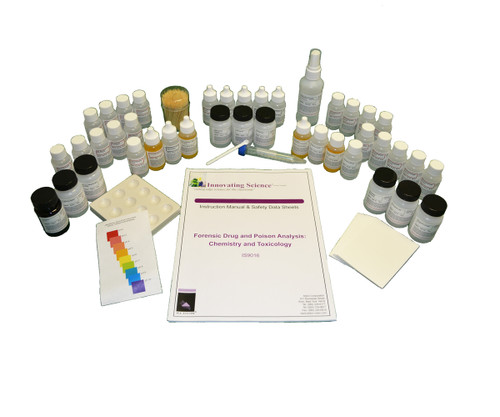
Forensic Drug Testing: A Simulated Immunoassay
Innovating Science
- SKU:
- CLIS-7023
- Shipping:
- Calculated at Checkout
- Grades:
- 7-10
- Group Size:
- 1-2
Drug testing comes in two forms, presumptive and confirmatory. Because of the cost associated with confirmatory testing, a presumptive test is often employed first. While there are various forms of presumptive drug testing, two of the most common techniques are immunoassay testing and thin-layer chromatography. In this activity, students will perform a simulated immunoassay test on several urine samples for the detection of the cocaine metabolite benzoylecgonine. All urine samples and testing reagents are simulated to avoid the potential hazards of actual biological specimens while still providing realistic results.
A drug is defined as a substance which has a physiological effect when introduced into the body. This definition encompasses a wide range of substances. Drugs can be further classified as being either a medicine or a recreational drug. A medicine is any drug that is prescribed and used in a specific way to treat or prevent a physical ailment/disease. Recreational drugs are ones taken solely for the purpose of obtaining the psychoactive or physiological effects of the drug without any medical justification. When a person uses a medicinal drug outside of the prescribed use, the medicine has now become a recreational drug.
For many centuries certain societies utilized drugs, both medicinally and recreationally, from natural sources with no understanding of what the drug was or how it functioned in the body. For example, it may have been known that ingesting leaves from a certain plant alleviated nausea. As scientific knowledge advanced, the specific compounds responsible in these plants were able to be identified, proving both beneficial and detrimental. For some medicinal drugs the compounds were able to be extracted and concentrated, providing more active compound in a smaller dose. In some cases, the structure of the drug was able to be altered into an even more effective form. The same unfortunately proved true for recreational drugs, allowing for the synthesis of not only a more concentrated form of the drug but also a more addictive form.
When an outside substance, such as a drug, is introduced into the body, natural biochemical processes will typically alter the material. In other words, the initial chemical structure of the material is changed through metabolic processes that occur within the body. These biologically altered versions of the initial chemical are called metabolites and these metabolites are eventually excreted from the body through standard waste removal processes (e.g. urination, perspiration). Some substances may undergo a simple chemical change before they eventually exit the body and some substances may undergo several chemical changes, forming multiple metabolites prior to excretion.
This Kit contains enough materials for 15 groups. Teacher’s Guide and Student Study Guide copy masters are included.
Components
Kit Includes:
5mL Positive Control
5mL Negative Control
5mL Specimen 1
5mL Specimen 2
5mL Specimen 3
5mL Specimen 4
5mL Specimen 5
5mL Specimen 6
30mL Antibody Solution
30mL Labeled Metabolite
15 Spot Plates






